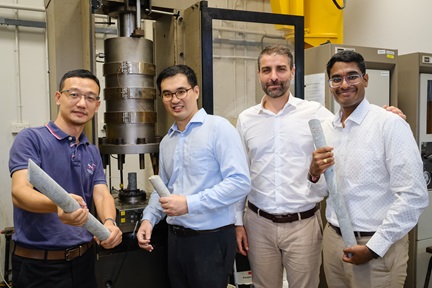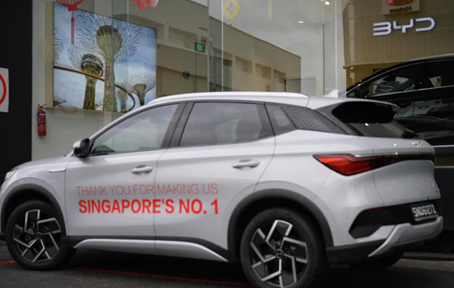New software could make lithium-ion batteries safer, longer-lasting
First published online at The Straits Times

Durapower CEO Kelvin Lim (left) and NTU Assistant Professor Hung Dinh Nguyen in a container-sized energy storage solution test bed containing lithium-ion batteries on the NTU campus.
SINGAPORE - A new technology aims to harness artificial intelligence to make lithium-ion batteries – used in everything from personal mobility devices to electric cars – safer by reducing their risk of catching fire.
The system, developed by scientists from the Nanyang Technological University (NTU) and energy storage solutions firm Durapower, uses a “digital twin” that mirrors an actual battery, allowing for accurate, real-time monitoring and predictions of battery conditions up to five years ahead.
Dubbed the Fire and Explosion Management System (FXMS), the technology can predict when to replace a battery pack that is likely to fail, with up to 95 per cent accuracy, up to six months ahead of time.
Lithium-ion batteries are widely used as they are lightweight and have high energy density.
However, there are possible issues such as damage from overcharging and accelerated reactions when overheated – a serious risk in hot and humid Singapore, said Assistant Professor Hung Dinh Nguyen, one of the project’s leads.
The patent-pending FXMS would act as a form of predictive maintenance so that corrective action can be taken before such situations occur, he added.
This is especially important with increasing demand for electric vehicles in Singapore as it moves towards its target of having all vehicles here run on cleaner energy by 2040, noted Prof Nguyen, who is cluster director of Renewables’ Integration & Microgrids at the Energy Research Institute at NTU.
One of the technology’s advantages is that it can increase battery life by up to 50 per cent.
This means that the battery of an electric car – which has a lifespan of about eight years with regular use – could last up to 12 years.
Prof Nguyen said that while software that can simulate batteries exists on the market, FXMS is faster and more efficient than such alternatives – taking just 8 seconds to simulate one hour of a battery’s operations, compared with up to 40 minutes for other software.
“Since our technology is cloud-based, it is scalable and can easily be adapted for consumer electronics such as mobility devices, laptops and mobile phones, helping the batteries to last longer and in the long run, reduce electronic waste and carbon footprint,” he added.
In future, consumers could use an app to personally monitor the condition of batteries in their devices, Assistant Professor Nguyen said, noting that several leading auto manufacturers have already expressed interest in the technology.
NTU said that for large battery storage systems such as those used in renewable energy grids or data centres, the use of digital twin technology would allow for electrical load to be rerouted to prolong the life of weaker batteries, or for the use of a battery pack to be stopped temporarily until it can be replaced.
The technology could potentially help reduce carbon emission through the reduction of battery waste, as batteries require a lot of resources and energy to manufacture, the university added.
Ageing battery packs, such as those in electric vehicles, are commonly repurposed for “second life” applications such as energy storage – and a digital twin could help monitor their condition, said Durapower chief executive Kelvin Lim.
“This is very important because as the industry is talking about second life batteries, repurposed batteries, no one knows enough about how the batteries have aged over time,” he added, pointing to the use of such batteries in areas such as stabilising the electrical grid in rural areas.







